


Tom A. Warner shows us what lightning looks like when you slow it down an incredible amount.
From Gruber here is a mention of another product (this one is the ASUS Eee Pad) that is dropping Windows CE in favor of Android. Gruber points out that you can see the same graphic (minus robots) in Steve Ballmer's presentation slide here. A couple of thoughts:
1) there will be many iPad rivals
2) most of them will probably not use Windows
The new competition is between Apple and Google. We will see some astounding products come to market in the next few years. Almost as many will dissapear as this rapid evolution runs its course. The winner in this competition will be consumers no matter who captures the most hearts and minds.
Shawn Blanc here suggests that CSS is the new Photoshop and points to some great examples. I argue that CSS is not the new Photoshop. CSS and HTML5 and Javascript together form the new PostScript. What PostScript was for desktop publishing, CSS, HTML5, and Javascript are for the modern web page. What is missing is the new PageMaker.
Most people don't know much about PostScript except maybe that it was Adobe's first product. The founders of Adobe wrote this powerful graphic programming language to describe pages for printers. Their first customer was Apple. PostScript was used as the page description language for Apple's first laser printer. It enabled the desktop publishing revolution by becoming the lingua franca of printers and publishing systems. Very few people directly wrote PostScript. (I did, but that is another story.) It was usually generated by publishing applications like PageMaker or Quark. It was also generated by print drivers on Mac, Windows and Unix. In those days, mostly programmers who wrote printer drivers wrote PostScript code. The point here is that designers did their layout by drawing and moving objects on a screen, not by writing code.
CSS, HTML5, and Javascript combine to form the way to describe pages on modern browsers much like PostScript was the way to describe pages on printers. In some cases PostScript was even used to drive displays. Steve Jobs licensed Display PostScript from Adobe as the display language for the NeXT computer before he returned to Apple.
What is missing today is the modern day equivalent of Illustrator and PageMaker for CSS, HTML5 and Javascript. Designers and artists should not need to directly write code to express art or layout. I suspect that many are working in this area. Any day now, I'm hoping that someone or some company will start to release products that bridge this huge gap.
Part of the problem is how to make a tool that will have the universal appeal of a PageMaker or Illustrator. Those applications were massively popular because of how well they solved the problems of laying out a page and drawing in vectors. Given the broad and somewhat disjointed characteristics of CSS, HTML5, and Javascript, coming up with a UI to rule them all is a big opportunity for UI gurus. How to make the result efficient enough to be useful in a production environment represents a significant programming challenge.
Adobe is the most likely to succeed in this if they can figure out how to market such a thing without undercutting Flash. Apple may also do something here.

Many people complain that Apple's iOS app approval system is too tightly controlled and like the ease with which Android apps can be distributed.
From Mashable here is news of a report from SMobile Systems providing a threat analysis of Android apps. Their report discusses a review of 48,000 apps which show issues that should be of concern to Android users. They include 5% that can call anywhere without the user's permission, 3% that can SMS anywhere, 383 apps that can read or use authentication credentials from another service or app and 29 apps that request permissions similar to spyware. Many or all of these apps may be fine but it is impossible for an app purchaser to have complete confidence in them. Finding a way to vet apps may be a good idea since, back in January, as reported by Gizmodo here there were some 'banking' apps that were used to phish for Android user banking logins.
From a consumer's viewpoint, Apple's checking of apps sounds like a great idea to me. Even if Apple misses something, if a problem comes to light then Apple can remotely revoke a specific app. These seem like strong selling points to businesses and concerned consumers.
The report pdf is available here.
There is a TechCrunch article here about how Scribd has made the presentations they host available in HTML5. By doing this, these presentations can now be viewed on iPhones and iPads as well as in other HTML5 compliant browsers. They are finding that their 50 million viewers per month are staying longer.
Lukas Mathis was cited by Gruber here regarding things that are not obvious in the world of gestures common to the iPad and iPhone.
There was a time when people thought that once we had icons then everything would be obvious and simple. While icons were not always obvious or intuitive at least they provided a graphic representation of an action. Gestures, since there is usually no graphic affordance associated with them are actually invisible and often only discovered by experimentation.
The thoughtful Lukas Mathis article is here.
Marko Gargenta gave a great Android development overview at a IEEE Computer Society meeting at Microsoft Research in Sunnyvale, CA on April 2010. His page with a video is here.
Android: A 9,000-foot Overview
This is a list of software, services, and information I often use or refer others to. Some of the links have discount codes where I know them. The discounts may be expired by the time you see this but if an item is on the list it is something I at least suggest considering regardless of price.
Storage/Backup
reliable local storage: Drobo
online backup carbonite.com offer code twig
online file sharing/syncing: dropbox.com (has applications for Mac, Windows, iPhone, Android)
The Ultimate Dropbox Toolkit & Guide
Websites
website creation/hosting: squarespace.com/twit
rails hosting: heroku.com; engineyard.com
Mac OSX superuser tips and tricks for Terminal
Screen Sharing
gotomypc.com
gotomeeting.com
gotoassist.com
gototraining.com
Web Tools
instapaper.com (web, iPhone...)
simplenoteapp.com (web, iPhone...)
iPad (some I use, some are recommended by others)
elements - $4.99 - Dropbox Powered Text editor
InstaPaper - $4.99 - very popular way for deferred viewing of web pages
Evernote - free - popular way to save stuff forever
Software
mac/win(beta)/ipad/iphone password manager: 1password.com
all platform password manager: lastpass.com
pazera software - YouTube download, video conversion for Windows: http://www.pazera-software.com/
Downloader+ 1.8 for Mac - untested by me
photo sharpening plugin: http://www.topazlabs.com/infocus/
Cables
if you have time to buy online: http://www.monoprice.com
Best Practices
keynote on iPad: http://support.apple.com/kb/HT4114
Things I will use
These are some items I'll want to find again:
very cool diff application for Macintosh: http://www.kaleidoscopeapp.com/
cool way to make a drive from home accessible everywhere: http://www.pogoplug.com
Things I may need to help others to find:
http://windowslive.com/desktop/moviemaker
http://explore.live.com/windows-live-movie-maker
http://www.quirky.com - invention site
http://www.yurbuds.com/ - attachments for iPod earbuds that make them more comfortable; suggested by Peter Krasa
 This item ran in the Christian Science Monitor here a week ago so it is old news. Quoting directly from the story,"Jens Stoltenberg, the Norwegian prime minister, is stranded in New York today as ash from the Iceland volcano continues to disrupt flights to and from northern Europe. Good thing he has an Apple iPad."
This item ran in the Christian Science Monitor here a week ago so it is old news. Quoting directly from the story,"Jens Stoltenberg, the Norwegian prime minister, is stranded in New York today as ash from the Iceland volcano continues to disrupt flights to and from northern Europe. Good thing he has an Apple iPad."
In computing we sometimes speak of a computer or an application our mom could use. It may sound flippant but actually it is a lofty goal and a sign of success when we make something accessible to people who are not tech geeks. When the Macintosh was introduced it was promoted as the computer for "the rest of us." While the Macintosh and later Windows did greatly expand the number of people who found computers accessible and useful neither fully encompassed "the rest of us." Giant applications, inconsistent user interfaces, creeping complexity, and predatory viruses have all conspired to make Windows and to a lesser degree Macintoshes harder for non geeks to approach.
In a triumph of design and execution that must warm the hearts of Steve Jobs, Jonathan Ive, and all the other people at Apple a 99 year old woman in Oswego, Oregon named Virginia Cambell is now a happy Apple customer. The iPad is the first computer Virginia has owned. According to the Oregonian here she asked her daughter to get one for her.
The backlit display allows her to read despite her glaucoma. She also composes her poetry on her iPad.
To this technology-ninny it’s clear
In my compromised 100th year,
That to read and to write
Are again within sight
Of this Apple iPad pioneer.
She even has a viral video on YouTube:
From TUAW here comes news about a product coming soon from design firm MAYA.
Their idea gives you a place to carry your iPad and make it useful while riding your bike. I particularly like the idea of providing "in flight entertainment" for the rider on the back of a bicycle built for two. The link to MAYA Sprocket is here.
Cringely reports here about the passing of Ed Roberts who designed the Altair 8800.
This was the first micro computer I owned and tried to make work. I bought the MiTS Altair kit when I lived in Chicago, soldered it together and before I'd finished trouble shooting it I'd left Chicago for Burbank. I sold the not yet working machine to an engineer I knew would be able to make it work.
My Altair had a lot of memory for the time, an S100 board with 16K that cost over $700.
The Altair 8800 was the first microcomputer Bill Gates and Paul Allen wrote commercial software for. They created Altair-Basic which became the basis for Microsoft.
Besides Microsoft, this was the same machine that gave the start to companies like Peachtree Software in Atlanta who built the first microcomputer accounting system for the Altair - written in Basic.
We've come a long way from the first commercially successful microcomputer to the iPad. It is sobering to realize that the $700 I spent back then for 16K of memory alone can now buy a 64GB iPad.
We owe a lot to pioneers like Ed Roberts.
From Gruber comes a pointer to an extraordinary collection of 80 images of Tokyo here produced using HRD (High Dynamic Range) imaging techniques. These techniques involve shooting multiple images of the same subject with a range of exposures and then combining the images with software to create a resuling image with a higher dynamic range than the camera's sensor can produce in a single exposure.
Gazelle.com seems to have a great system for clearing out your drawers of old tech gadgets for cash. You can set it up to collect items for cash for your cause as well.